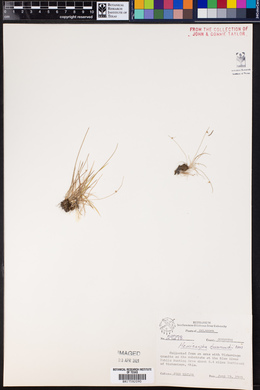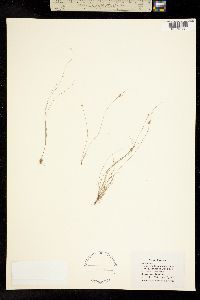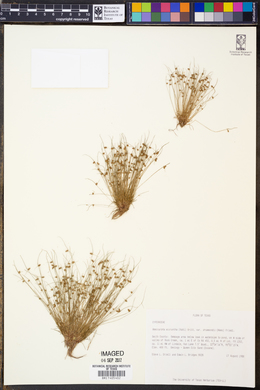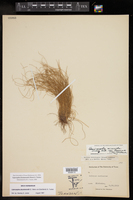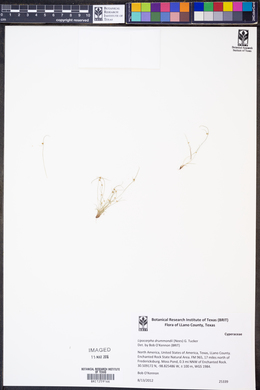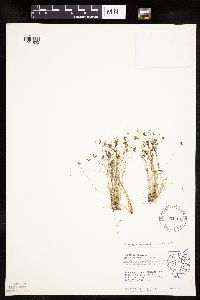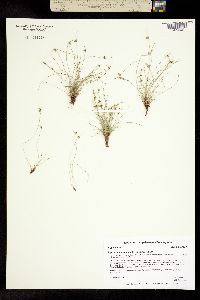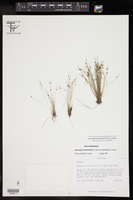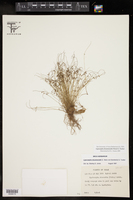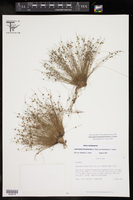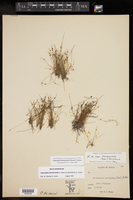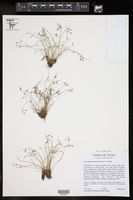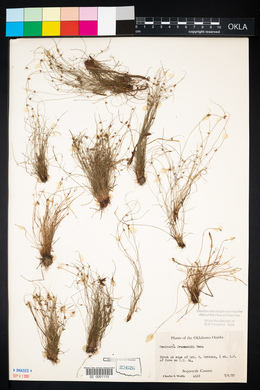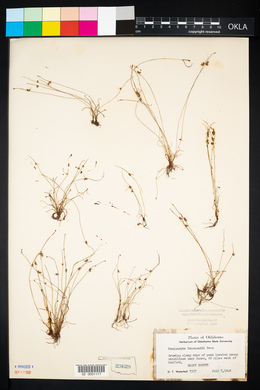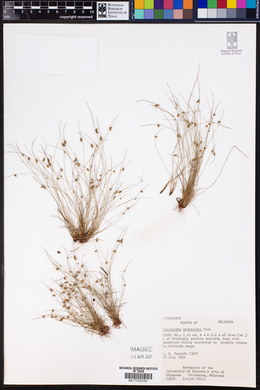Cyperus hemidrummondii
|
|
|
|
Family: Cyperaceae
Drummond's Halfchaff Sedge, more...Drummond's Halfchaff Sedge
[Hemicarpha drummondii Nees, moreHemicarpha micrantha var. drummondii (Nees) Friedland, Lipocarpha drummondii (Nees) G. C. Tucker, Scirpus micranthus var. drummondii (Nees) Mohlenbrock] |
Culms 2-12 cm × (0.2-)0.3-0.5 mm. Leaves 1-3 cm × 0.3-0.6 mm; longest involucral leaf ± erect. Inflorescences: spikes 1-2(-3), ovoid (to globose), 1-5(-6) × 1-2 mm, not bristly; bracts 1-2, longest erect, 0.5-2 cm × 0.3-0.5 mm. Spikelets: floral scales 2; 1st scale light brown to reddish brown, with greenish midvein, obtrullate, 0.9-1.3 × 0.3-0.6 mm, widest above mid length, long-acuminate; 2d scale reddish brown distally, with 2-4 reddish veins, oblong, 0.5-0.8 × 0.2 mm; 3d scale absent; stamen 1; anther 0.2 mm; stigmas 2. Achenes obovoid, terete, 0.5-0.75 × 0.25-0.35 mm, 1.5-2.5 times long as wide. Fruiting late summer-early fall. Emergent shorelines, usually sandy soils; 0-1200 m; Ariz., Ark., Ill., Ind., Kans., Mo., Nebr., N.Mex., Ohio, Okla., Tex., Wis. Annual herb, tufted 2 - 12 cm tall Leaves: basal, 1 - 3 cm long, to about 0.5 mm wide, linear, parallel-veined, with a sheathing base that encloses the stem. Inflorescence: a terminal, egg-shaped cluster of one to two spikes, 1 - 5 mm long, 1 - 2 mm wide, subtended by leaf-like bracts. Bracts one to two, longest upright, 0.5 - 2 cm long, to 0.5 mm wide. Spikes composed of numerous spikelets. Flowers: minute, subtended by a floral scale, lacking sepals and petals, with one or two scales. Stamen one, exserted. Pistil one. Style linear, two- to three-cleft. Fruit: a one-seeded achene, 0.5 - 0.75 mm long, about 0.25 mm wide, 1.5 to 2.5 times as long as wide, reverse egg-shaped, circular in cross-section. Seed with a thin, non-adherent wall. Culm: 2 - 12 cm long, to 0.5 mm wide, circular in cross-section, solid. Spikelets: bearing two floral scales. First scale light brown to reddish brown with a greenish midrib, about 1 mm long and 0.5 mm wide, more or less diamond-shaped (but widest above the middle), long-pointed. Second scale reddish brown above with two to four reddish veins, about 0.5 mm long and 0.2 mm wide, oblong. Similar species: No information at this time. Flowering: August to October Habitat and ecology: Rare in the Chicago Region. Found in wet, sandy soil. Occurence in the Chicago region: native Etymology: Lipocarpha comes from the Greek words lipos, meaning fat, and carphos, meaning chaff, referring to the inner scale thickness of some species. Drummondii is named after Thomas Drummond, a 19th century Scottish naturalist. Author: The Morton Arboretum FNA 2002 Common Name: Drummond's halfchaff sedge Duration: Annual Nativity: Native Lifeform: Graminoid General: Tufted annual, not rhizomatous with solitary terete stems 2-12 cm by 0.5 mm thick. Vegetative: Leaves basal, with the lower bladeless or with an involute appendage, upper with distinct glabrous blade 1-3 cm long by 0.3-0.6 mm wide, the longest involucral leaf more or less erect. Inflorescence: Terminal spikes 1-2, ovoid to globose, 1-5 mm by 1-2 mm, not bristly with 1-2 bracts, the longest of these erect, 0.5-2 cm by 0.5 mm wide; the spikelets made of 2 floral scales, the first light brown to reddish brown, with greenish midvein, with widest axis above the middle and with no straight margins, widest above midlength; second scale reddish brown above with 2-4 reddish veins, oblong, 0.5 mm by 0.2 mm wide, third scale absent; achenes obovoid, terete, 0.5-0.75 mm by 0.25-0.35 mm, 1.5-2.5 times long as wide. Ecology: Found on emergent shorelines in sandy soils to 4,000 ft (1219 m); flowers August-September. Notes: Very similar to L. aristulata, can be distinguished by the outer scale being widest from the tip to the midlength, with the second scale reddish brown above. Advice- Take a specimen and get a scope. Prognosis- Not a good chance it is here, but you never know. Ethnobotany: Unknown Etymology: Lipocarpha comes from Greek leipo, meaning to be deficient or wanting, and karphos for chip of straw, while drummondii is named for Thomas Drummond (1790-1835) a Scottish naturalist. Synonyms: Hemicarpha drummondii, Hemicarpha micrantha var. drummondii, Scirpus micranthus var. drummondii Editor: SBuckley, 2010 From Flora of Indiana (1940) by Charles C. Deam Found only in wet sand on the borders of sloughs or in sloughs when dried up, in wet, interdunal flats in the dune area, and in a dredged ditch in Newton County. .…… Indiana Coefficient of Conservatism: C =10 Wetland Indicator Status: FACW |
|
|
|










